University Epidemiology Paper: Critical Appraisal of Research Study
VerifiedAdded on 2020/03/16
|13
|3561
|44
Report
AI Summary
This report critically appraises a research paper examining the association between dietary factors and the risk of esophageal and gastric cardia adenocarcinoma. The study, conducted in Sweden, investigated the impact of foods like tomatoes, mint, and citrus fruits on reflux and cancer development. The methodology involved interviews using food frequency questionnaires and statistical analyses, including Spearman correlation and odds ratio calculations. The findings revealed a negligible causal association between the consumption of LES-relaxing foods and the occurrence of either adenocarcinoma, with some foods like leeks, onions, and garlic potentially reducing cancer risk. The report highlights the study's internal validity, potential biases, and limitations, such as recall bias and the possibility of confounding factors. The study suggests that dietary factors have a non-causal association with the occurrence of the two types of cancers. The report concludes by acknowledging limitations and biases within the study, emphasizing the need for further research.
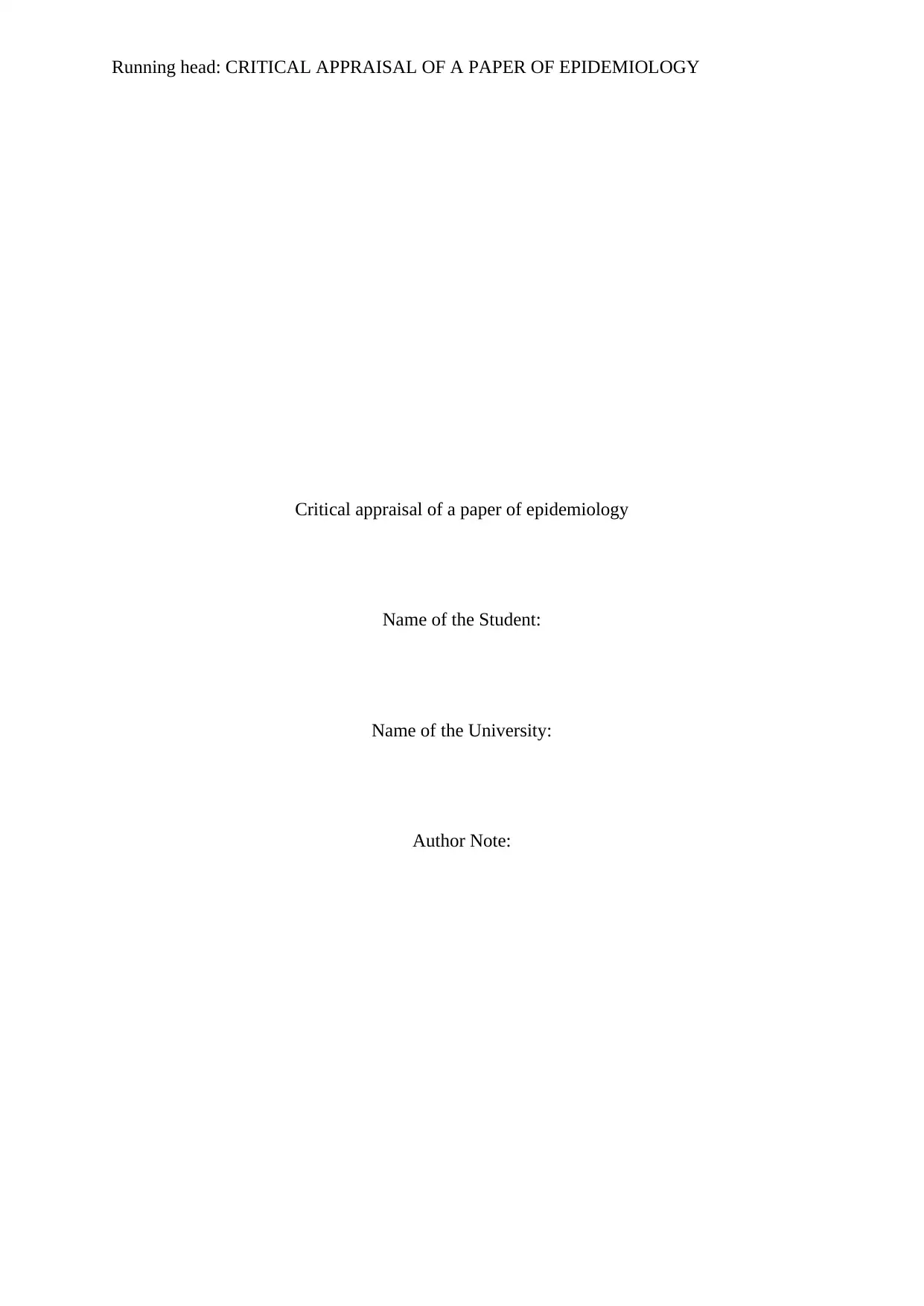
Running head: CRITICAL APPRAISAL OF A PAPER OF EPIDEMIOLOGY
Critical appraisal of a paper of epidemiology
Name of the Student:
Name of the University:
Author Note:
Critical appraisal of a paper of epidemiology
Name of the Student:
Name of the University:
Author Note:
Paraphrase This Document
Need a fresh take? Get an instant paraphrase of this document with our AI Paraphraser
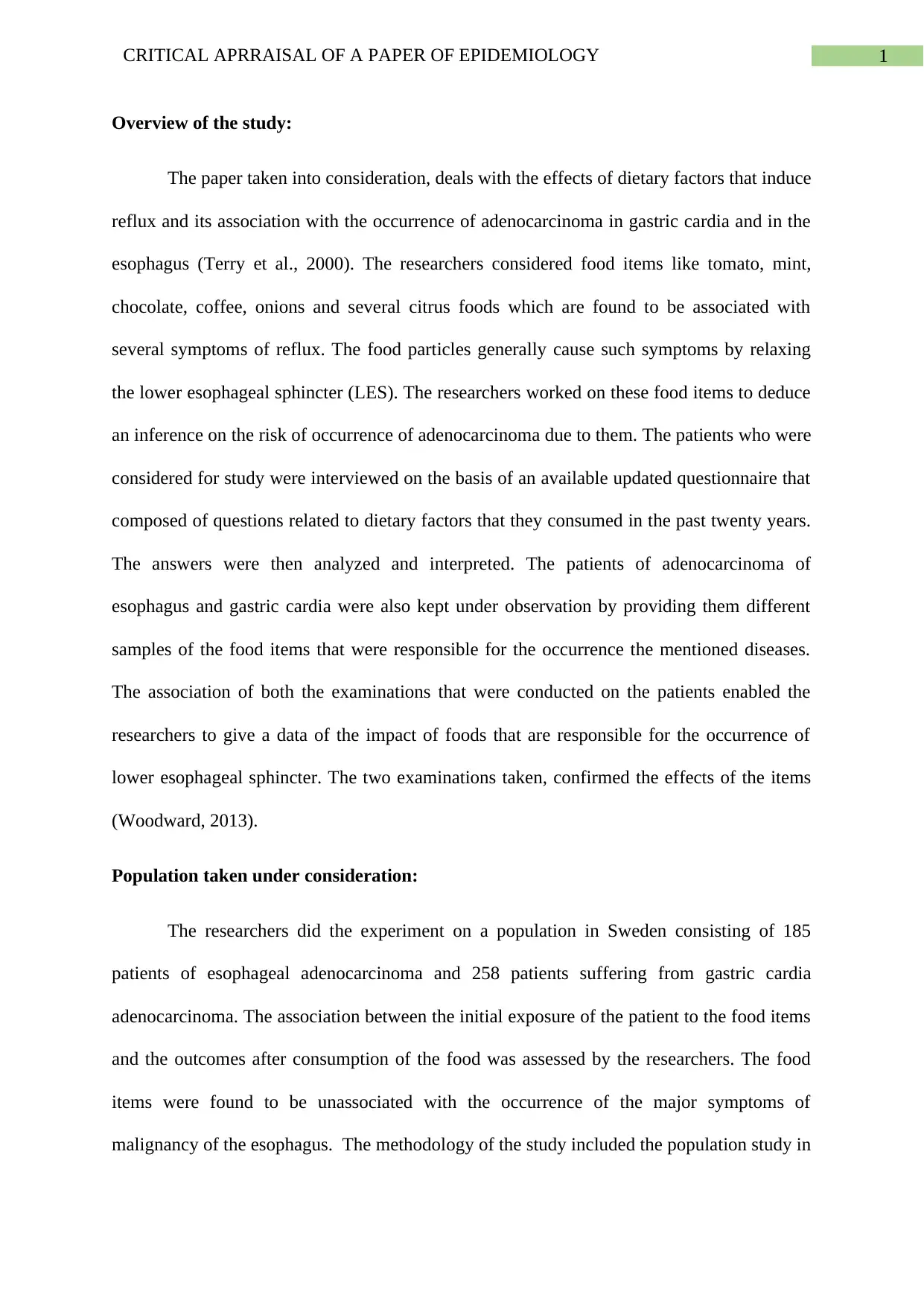
1CRITICAL APRRAISAL OF A PAPER OF EPIDEMIOLOGY
Overview of the study:
The paper taken into consideration, deals with the effects of dietary factors that induce
reflux and its association with the occurrence of adenocarcinoma in gastric cardia and in the
esophagus (Terry et al., 2000). The researchers considered food items like tomato, mint,
chocolate, coffee, onions and several citrus foods which are found to be associated with
several symptoms of reflux. The food particles generally cause such symptoms by relaxing
the lower esophageal sphincter (LES). The researchers worked on these food items to deduce
an inference on the risk of occurrence of adenocarcinoma due to them. The patients who were
considered for study were interviewed on the basis of an available updated questionnaire that
composed of questions related to dietary factors that they consumed in the past twenty years.
The answers were then analyzed and interpreted. The patients of adenocarcinoma of
esophagus and gastric cardia were also kept under observation by providing them different
samples of the food items that were responsible for the occurrence the mentioned diseases.
The association of both the examinations that were conducted on the patients enabled the
researchers to give a data of the impact of foods that are responsible for the occurrence of
lower esophageal sphincter. The two examinations taken, confirmed the effects of the items
(Woodward, 2013).
Population taken under consideration:
The researchers did the experiment on a population in Sweden consisting of 185
patients of esophageal adenocarcinoma and 258 patients suffering from gastric cardia
adenocarcinoma. The association between the initial exposure of the patient to the food items
and the outcomes after consumption of the food was assessed by the researchers. The food
items were found to be unassociated with the occurrence of the major symptoms of
malignancy of the esophagus. The methodology of the study included the population study in
Overview of the study:
The paper taken into consideration, deals with the effects of dietary factors that induce
reflux and its association with the occurrence of adenocarcinoma in gastric cardia and in the
esophagus (Terry et al., 2000). The researchers considered food items like tomato, mint,
chocolate, coffee, onions and several citrus foods which are found to be associated with
several symptoms of reflux. The food particles generally cause such symptoms by relaxing
the lower esophageal sphincter (LES). The researchers worked on these food items to deduce
an inference on the risk of occurrence of adenocarcinoma due to them. The patients who were
considered for study were interviewed on the basis of an available updated questionnaire that
composed of questions related to dietary factors that they consumed in the past twenty years.
The answers were then analyzed and interpreted. The patients of adenocarcinoma of
esophagus and gastric cardia were also kept under observation by providing them different
samples of the food items that were responsible for the occurrence the mentioned diseases.
The association of both the examinations that were conducted on the patients enabled the
researchers to give a data of the impact of foods that are responsible for the occurrence of
lower esophageal sphincter. The two examinations taken, confirmed the effects of the items
(Woodward, 2013).
Population taken under consideration:
The researchers did the experiment on a population in Sweden consisting of 185
patients of esophageal adenocarcinoma and 258 patients suffering from gastric cardia
adenocarcinoma. The association between the initial exposure of the patient to the food items
and the outcomes after consumption of the food was assessed by the researchers. The food
items were found to be unassociated with the occurrence of the major symptoms of
malignancy of the esophagus. The methodology of the study included the population study in
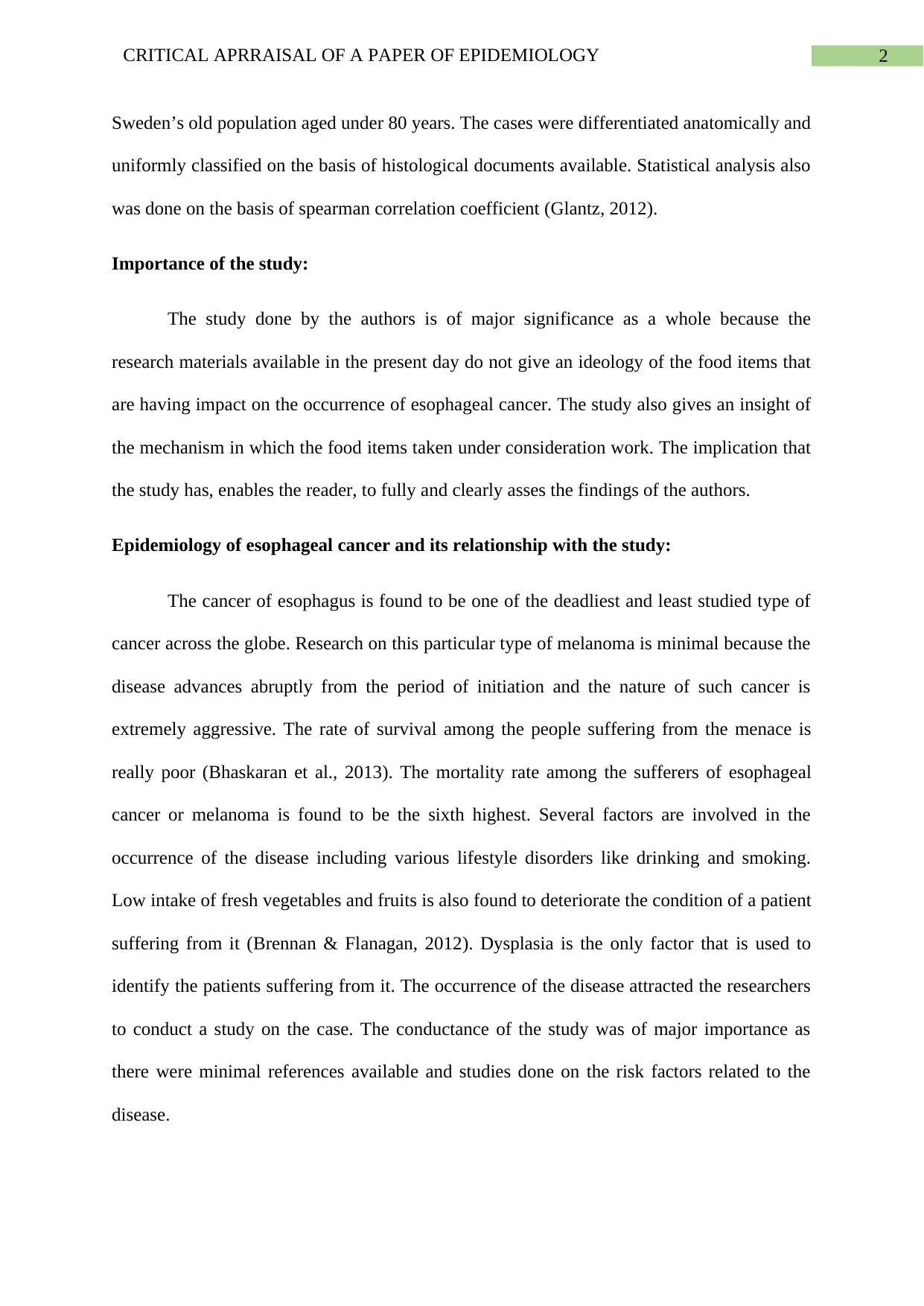
2CRITICAL APRRAISAL OF A PAPER OF EPIDEMIOLOGY
Sweden’s old population aged under 80 years. The cases were differentiated anatomically and
uniformly classified on the basis of histological documents available. Statistical analysis also
was done on the basis of spearman correlation coefficient (Glantz, 2012).
Importance of the study:
The study done by the authors is of major significance as a whole because the
research materials available in the present day do not give an ideology of the food items that
are having impact on the occurrence of esophageal cancer. The study also gives an insight of
the mechanism in which the food items taken under consideration work. The implication that
the study has, enables the reader, to fully and clearly asses the findings of the authors.
Epidemiology of esophageal cancer and its relationship with the study:
The cancer of esophagus is found to be one of the deadliest and least studied type of
cancer across the globe. Research on this particular type of melanoma is minimal because the
disease advances abruptly from the period of initiation and the nature of such cancer is
extremely aggressive. The rate of survival among the people suffering from the menace is
really poor (Bhaskaran et al., 2013). The mortality rate among the sufferers of esophageal
cancer or melanoma is found to be the sixth highest. Several factors are involved in the
occurrence of the disease including various lifestyle disorders like drinking and smoking.
Low intake of fresh vegetables and fruits is also found to deteriorate the condition of a patient
suffering from it (Brennan & Flanagan, 2012). Dysplasia is the only factor that is used to
identify the patients suffering from it. The occurrence of the disease attracted the researchers
to conduct a study on the case. The conductance of the study was of major importance as
there were minimal references available and studies done on the risk factors related to the
disease.
Sweden’s old population aged under 80 years. The cases were differentiated anatomically and
uniformly classified on the basis of histological documents available. Statistical analysis also
was done on the basis of spearman correlation coefficient (Glantz, 2012).
Importance of the study:
The study done by the authors is of major significance as a whole because the
research materials available in the present day do not give an ideology of the food items that
are having impact on the occurrence of esophageal cancer. The study also gives an insight of
the mechanism in which the food items taken under consideration work. The implication that
the study has, enables the reader, to fully and clearly asses the findings of the authors.
Epidemiology of esophageal cancer and its relationship with the study:
The cancer of esophagus is found to be one of the deadliest and least studied type of
cancer across the globe. Research on this particular type of melanoma is minimal because the
disease advances abruptly from the period of initiation and the nature of such cancer is
extremely aggressive. The rate of survival among the people suffering from the menace is
really poor (Bhaskaran et al., 2013). The mortality rate among the sufferers of esophageal
cancer or melanoma is found to be the sixth highest. Several factors are involved in the
occurrence of the disease including various lifestyle disorders like drinking and smoking.
Low intake of fresh vegetables and fruits is also found to deteriorate the condition of a patient
suffering from it (Brennan & Flanagan, 2012). Dysplasia is the only factor that is used to
identify the patients suffering from it. The occurrence of the disease attracted the researchers
to conduct a study on the case. The conductance of the study was of major importance as
there were minimal references available and studies done on the risk factors related to the
disease.
⊘ This is a preview!⊘
Do you want full access?
Subscribe today to unlock all pages.

Trusted by 1+ million students worldwide
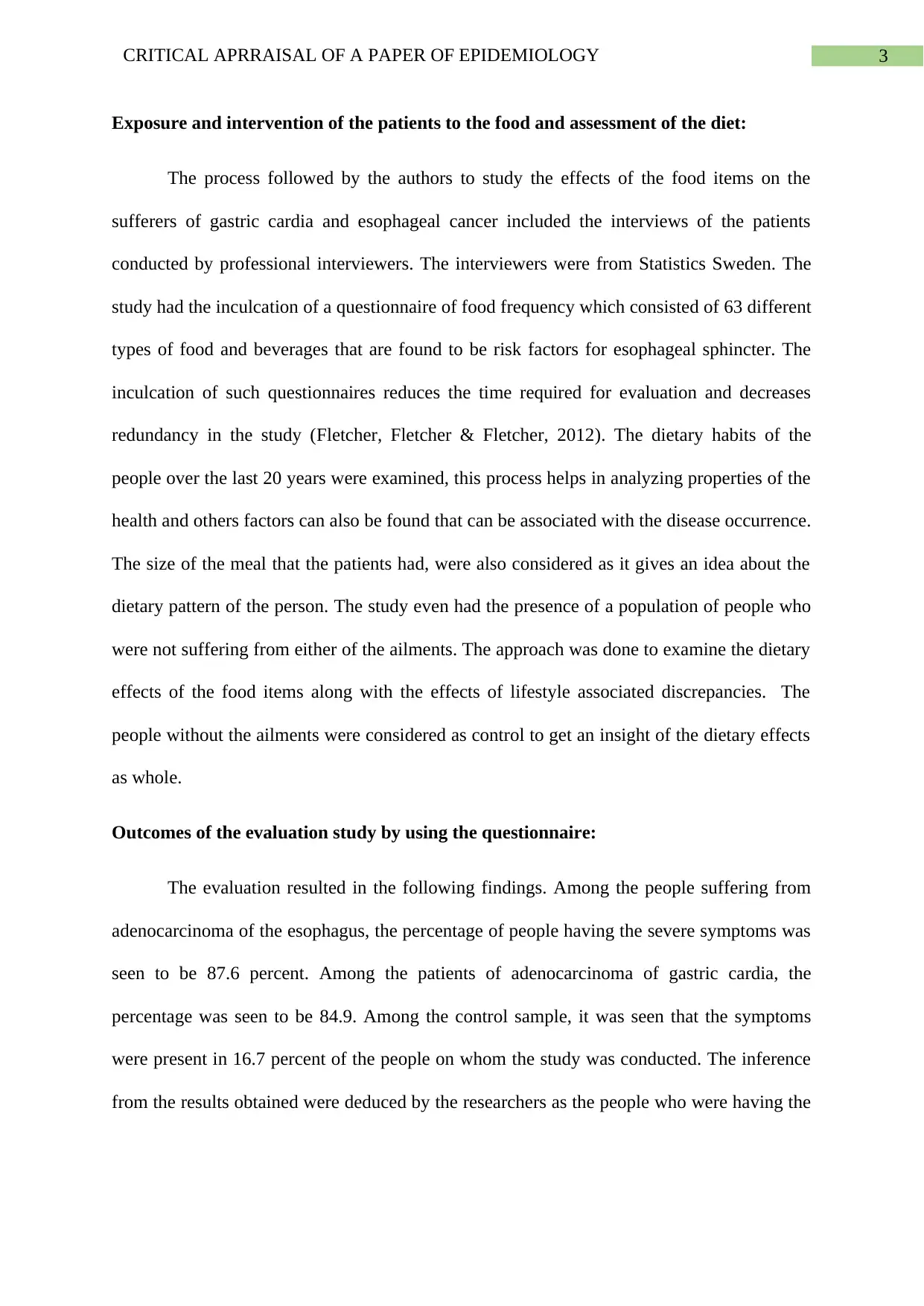
3CRITICAL APRRAISAL OF A PAPER OF EPIDEMIOLOGY
Exposure and intervention of the patients to the food and assessment of the diet:
The process followed by the authors to study the effects of the food items on the
sufferers of gastric cardia and esophageal cancer included the interviews of the patients
conducted by professional interviewers. The interviewers were from Statistics Sweden. The
study had the inculcation of a questionnaire of food frequency which consisted of 63 different
types of food and beverages that are found to be risk factors for esophageal sphincter. The
inculcation of such questionnaires reduces the time required for evaluation and decreases
redundancy in the study (Fletcher, Fletcher & Fletcher, 2012). The dietary habits of the
people over the last 20 years were examined, this process helps in analyzing properties of the
health and others factors can also be found that can be associated with the disease occurrence.
The size of the meal that the patients had, were also considered as it gives an idea about the
dietary pattern of the person. The study even had the presence of a population of people who
were not suffering from either of the ailments. The approach was done to examine the dietary
effects of the food items along with the effects of lifestyle associated discrepancies. The
people without the ailments were considered as control to get an insight of the dietary effects
as whole.
Outcomes of the evaluation study by using the questionnaire:
The evaluation resulted in the following findings. Among the people suffering from
adenocarcinoma of the esophagus, the percentage of people having the severe symptoms was
seen to be 87.6 percent. Among the patients of adenocarcinoma of gastric cardia, the
percentage was seen to be 84.9. Among the control sample, it was seen that the symptoms
were present in 16.7 percent of the people on whom the study was conducted. The inference
from the results obtained were deduced by the researchers as the people who were having the
Exposure and intervention of the patients to the food and assessment of the diet:
The process followed by the authors to study the effects of the food items on the
sufferers of gastric cardia and esophageal cancer included the interviews of the patients
conducted by professional interviewers. The interviewers were from Statistics Sweden. The
study had the inculcation of a questionnaire of food frequency which consisted of 63 different
types of food and beverages that are found to be risk factors for esophageal sphincter. The
inculcation of such questionnaires reduces the time required for evaluation and decreases
redundancy in the study (Fletcher, Fletcher & Fletcher, 2012). The dietary habits of the
people over the last 20 years were examined, this process helps in analyzing properties of the
health and others factors can also be found that can be associated with the disease occurrence.
The size of the meal that the patients had, were also considered as it gives an idea about the
dietary pattern of the person. The study even had the presence of a population of people who
were not suffering from either of the ailments. The approach was done to examine the dietary
effects of the food items along with the effects of lifestyle associated discrepancies. The
people without the ailments were considered as control to get an insight of the dietary effects
as whole.
Outcomes of the evaluation study by using the questionnaire:
The evaluation resulted in the following findings. Among the people suffering from
adenocarcinoma of the esophagus, the percentage of people having the severe symptoms was
seen to be 87.6 percent. Among the patients of adenocarcinoma of gastric cardia, the
percentage was seen to be 84.9. Among the control sample, it was seen that the symptoms
were present in 16.7 percent of the people on whom the study was conducted. The inference
from the results obtained were deduced by the researchers as the people who were having the
Paraphrase This Document
Need a fresh take? Get an instant paraphrase of this document with our AI Paraphraser
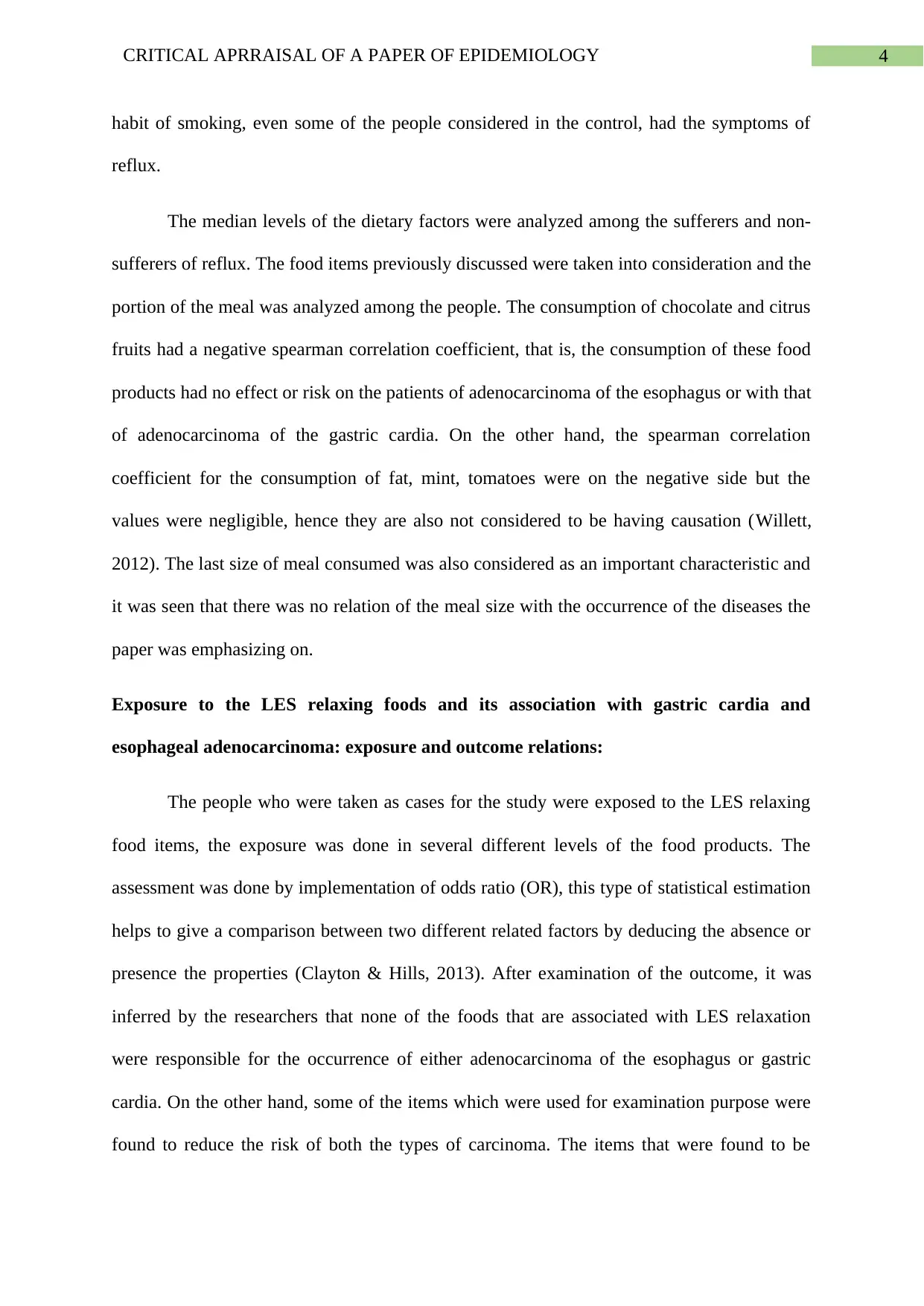
4CRITICAL APRRAISAL OF A PAPER OF EPIDEMIOLOGY
habit of smoking, even some of the people considered in the control, had the symptoms of
reflux.
The median levels of the dietary factors were analyzed among the sufferers and non-
sufferers of reflux. The food items previously discussed were taken into consideration and the
portion of the meal was analyzed among the people. The consumption of chocolate and citrus
fruits had a negative spearman correlation coefficient, that is, the consumption of these food
products had no effect or risk on the patients of adenocarcinoma of the esophagus or with that
of adenocarcinoma of the gastric cardia. On the other hand, the spearman correlation
coefficient for the consumption of fat, mint, tomatoes were on the negative side but the
values were negligible, hence they are also not considered to be having causation (Willett,
2012). The last size of meal consumed was also considered as an important characteristic and
it was seen that there was no relation of the meal size with the occurrence of the diseases the
paper was emphasizing on.
Exposure to the LES relaxing foods and its association with gastric cardia and
esophageal adenocarcinoma: exposure and outcome relations:
The people who were taken as cases for the study were exposed to the LES relaxing
food items, the exposure was done in several different levels of the food products. The
assessment was done by implementation of odds ratio (OR), this type of statistical estimation
helps to give a comparison between two different related factors by deducing the absence or
presence the properties (Clayton & Hills, 2013). After examination of the outcome, it was
inferred by the researchers that none of the foods that are associated with LES relaxation
were responsible for the occurrence of either adenocarcinoma of the esophagus or gastric
cardia. On the other hand, some of the items which were used for examination purpose were
found to reduce the risk of both the types of carcinoma. The items that were found to be
habit of smoking, even some of the people considered in the control, had the symptoms of
reflux.
The median levels of the dietary factors were analyzed among the sufferers and non-
sufferers of reflux. The food items previously discussed were taken into consideration and the
portion of the meal was analyzed among the people. The consumption of chocolate and citrus
fruits had a negative spearman correlation coefficient, that is, the consumption of these food
products had no effect or risk on the patients of adenocarcinoma of the esophagus or with that
of adenocarcinoma of the gastric cardia. On the other hand, the spearman correlation
coefficient for the consumption of fat, mint, tomatoes were on the negative side but the
values were negligible, hence they are also not considered to be having causation (Willett,
2012). The last size of meal consumed was also considered as an important characteristic and
it was seen that there was no relation of the meal size with the occurrence of the diseases the
paper was emphasizing on.
Exposure to the LES relaxing foods and its association with gastric cardia and
esophageal adenocarcinoma: exposure and outcome relations:
The people who were taken as cases for the study were exposed to the LES relaxing
food items, the exposure was done in several different levels of the food products. The
assessment was done by implementation of odds ratio (OR), this type of statistical estimation
helps to give a comparison between two different related factors by deducing the absence or
presence the properties (Clayton & Hills, 2013). After examination of the outcome, it was
inferred by the researchers that none of the foods that are associated with LES relaxation
were responsible for the occurrence of either adenocarcinoma of the esophagus or gastric
cardia. On the other hand, some of the items which were used for examination purpose were
found to reduce the risk of both the types of carcinoma. The items that were found to be
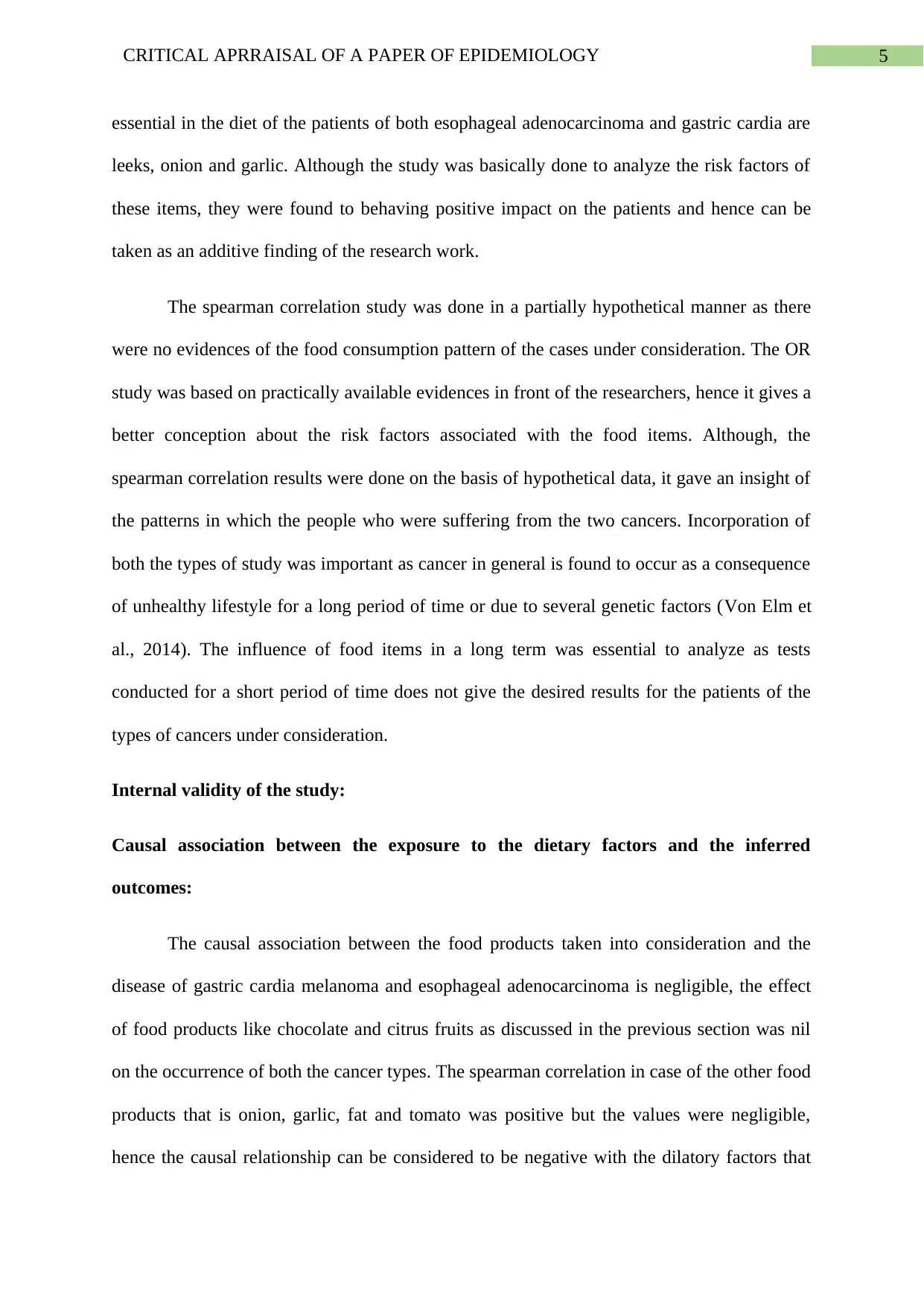
5CRITICAL APRRAISAL OF A PAPER OF EPIDEMIOLOGY
essential in the diet of the patients of both esophageal adenocarcinoma and gastric cardia are
leeks, onion and garlic. Although the study was basically done to analyze the risk factors of
these items, they were found to behaving positive impact on the patients and hence can be
taken as an additive finding of the research work.
The spearman correlation study was done in a partially hypothetical manner as there
were no evidences of the food consumption pattern of the cases under consideration. The OR
study was based on practically available evidences in front of the researchers, hence it gives a
better conception about the risk factors associated with the food items. Although, the
spearman correlation results were done on the basis of hypothetical data, it gave an insight of
the patterns in which the people who were suffering from the two cancers. Incorporation of
both the types of study was important as cancer in general is found to occur as a consequence
of unhealthy lifestyle for a long period of time or due to several genetic factors (Von Elm et
al., 2014). The influence of food items in a long term was essential to analyze as tests
conducted for a short period of time does not give the desired results for the patients of the
types of cancers under consideration.
Internal validity of the study:
Causal association between the exposure to the dietary factors and the inferred
outcomes:
The causal association between the food products taken into consideration and the
disease of gastric cardia melanoma and esophageal adenocarcinoma is negligible, the effect
of food products like chocolate and citrus fruits as discussed in the previous section was nil
on the occurrence of both the cancer types. The spearman correlation in case of the other food
products that is onion, garlic, fat and tomato was positive but the values were negligible,
hence the causal relationship can be considered to be negative with the dilatory factors that
essential in the diet of the patients of both esophageal adenocarcinoma and gastric cardia are
leeks, onion and garlic. Although the study was basically done to analyze the risk factors of
these items, they were found to behaving positive impact on the patients and hence can be
taken as an additive finding of the research work.
The spearman correlation study was done in a partially hypothetical manner as there
were no evidences of the food consumption pattern of the cases under consideration. The OR
study was based on practically available evidences in front of the researchers, hence it gives a
better conception about the risk factors associated with the food items. Although, the
spearman correlation results were done on the basis of hypothetical data, it gave an insight of
the patterns in which the people who were suffering from the two cancers. Incorporation of
both the types of study was important as cancer in general is found to occur as a consequence
of unhealthy lifestyle for a long period of time or due to several genetic factors (Von Elm et
al., 2014). The influence of food items in a long term was essential to analyze as tests
conducted for a short period of time does not give the desired results for the patients of the
types of cancers under consideration.
Internal validity of the study:
Causal association between the exposure to the dietary factors and the inferred
outcomes:
The causal association between the food products taken into consideration and the
disease of gastric cardia melanoma and esophageal adenocarcinoma is negligible, the effect
of food products like chocolate and citrus fruits as discussed in the previous section was nil
on the occurrence of both the cancer types. The spearman correlation in case of the other food
products that is onion, garlic, fat and tomato was positive but the values were negligible,
hence the causal relationship can be considered to be negative with the dilatory factors that
⊘ This is a preview!⊘
Do you want full access?
Subscribe today to unlock all pages.

Trusted by 1+ million students worldwide
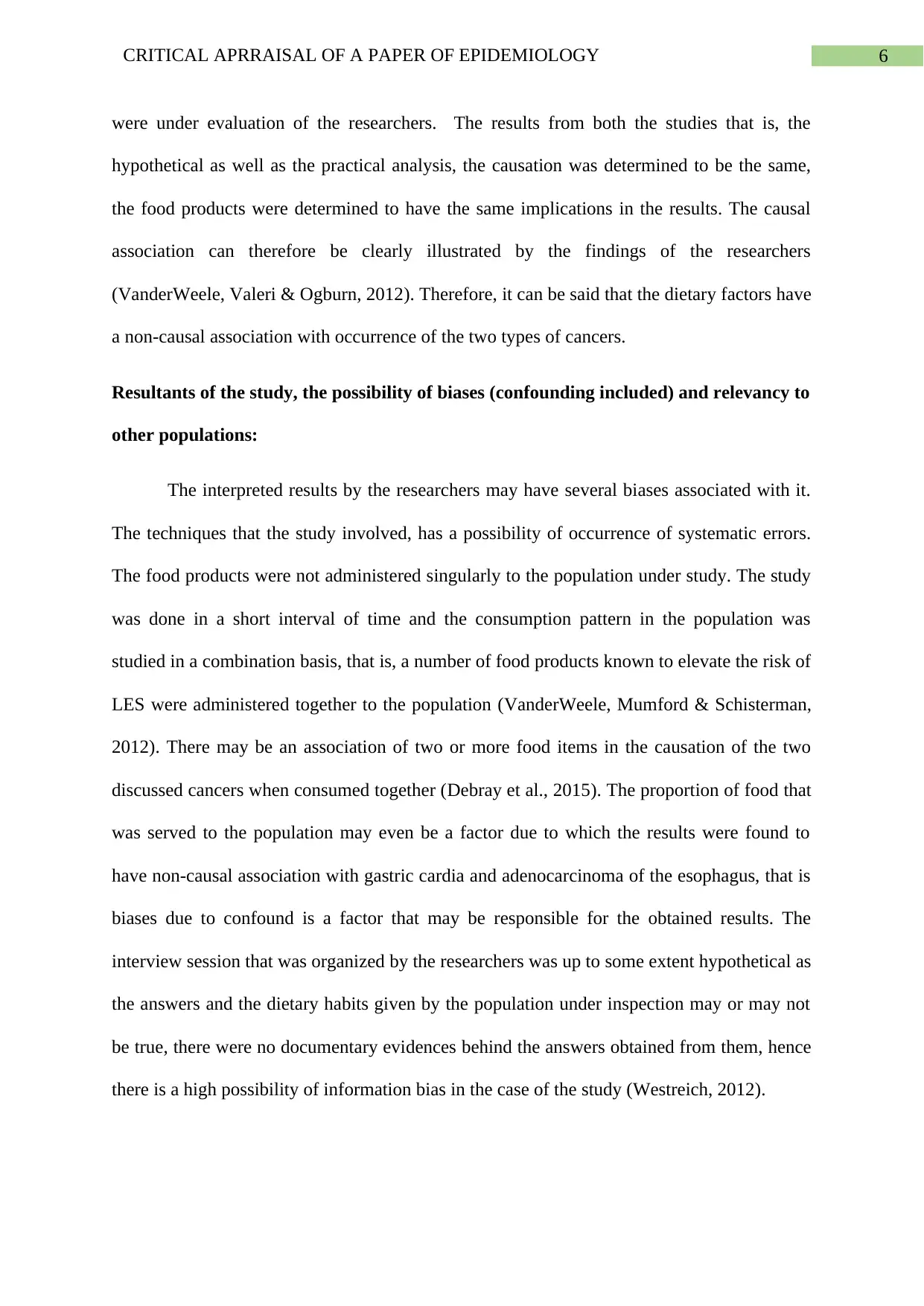
6CRITICAL APRRAISAL OF A PAPER OF EPIDEMIOLOGY
were under evaluation of the researchers. The results from both the studies that is, the
hypothetical as well as the practical analysis, the causation was determined to be the same,
the food products were determined to have the same implications in the results. The causal
association can therefore be clearly illustrated by the findings of the researchers
(VanderWeele, Valeri & Ogburn, 2012). Therefore, it can be said that the dietary factors have
a non-causal association with occurrence of the two types of cancers.
Resultants of the study, the possibility of biases (confounding included) and relevancy to
other populations:
The interpreted results by the researchers may have several biases associated with it.
The techniques that the study involved, has a possibility of occurrence of systematic errors.
The food products were not administered singularly to the population under study. The study
was done in a short interval of time and the consumption pattern in the population was
studied in a combination basis, that is, a number of food products known to elevate the risk of
LES were administered together to the population (VanderWeele, Mumford & Schisterman,
2012). There may be an association of two or more food items in the causation of the two
discussed cancers when consumed together (Debray et al., 2015). The proportion of food that
was served to the population may even be a factor due to which the results were found to
have non-causal association with gastric cardia and adenocarcinoma of the esophagus, that is
biases due to confound is a factor that may be responsible for the obtained results. The
interview session that was organized by the researchers was up to some extent hypothetical as
the answers and the dietary habits given by the population under inspection may or may not
be true, there were no documentary evidences behind the answers obtained from them, hence
there is a high possibility of information bias in the case of the study (Westreich, 2012).
were under evaluation of the researchers. The results from both the studies that is, the
hypothetical as well as the practical analysis, the causation was determined to be the same,
the food products were determined to have the same implications in the results. The causal
association can therefore be clearly illustrated by the findings of the researchers
(VanderWeele, Valeri & Ogburn, 2012). Therefore, it can be said that the dietary factors have
a non-causal association with occurrence of the two types of cancers.
Resultants of the study, the possibility of biases (confounding included) and relevancy to
other populations:
The interpreted results by the researchers may have several biases associated with it.
The techniques that the study involved, has a possibility of occurrence of systematic errors.
The food products were not administered singularly to the population under study. The study
was done in a short interval of time and the consumption pattern in the population was
studied in a combination basis, that is, a number of food products known to elevate the risk of
LES were administered together to the population (VanderWeele, Mumford & Schisterman,
2012). There may be an association of two or more food items in the causation of the two
discussed cancers when consumed together (Debray et al., 2015). The proportion of food that
was served to the population may even be a factor due to which the results were found to
have non-causal association with gastric cardia and adenocarcinoma of the esophagus, that is
biases due to confound is a factor that may be responsible for the obtained results. The
interview session that was organized by the researchers was up to some extent hypothetical as
the answers and the dietary habits given by the population under inspection may or may not
be true, there were no documentary evidences behind the answers obtained from them, hence
there is a high possibility of information bias in the case of the study (Westreich, 2012).
Paraphrase This Document
Need a fresh take? Get an instant paraphrase of this document with our AI Paraphraser
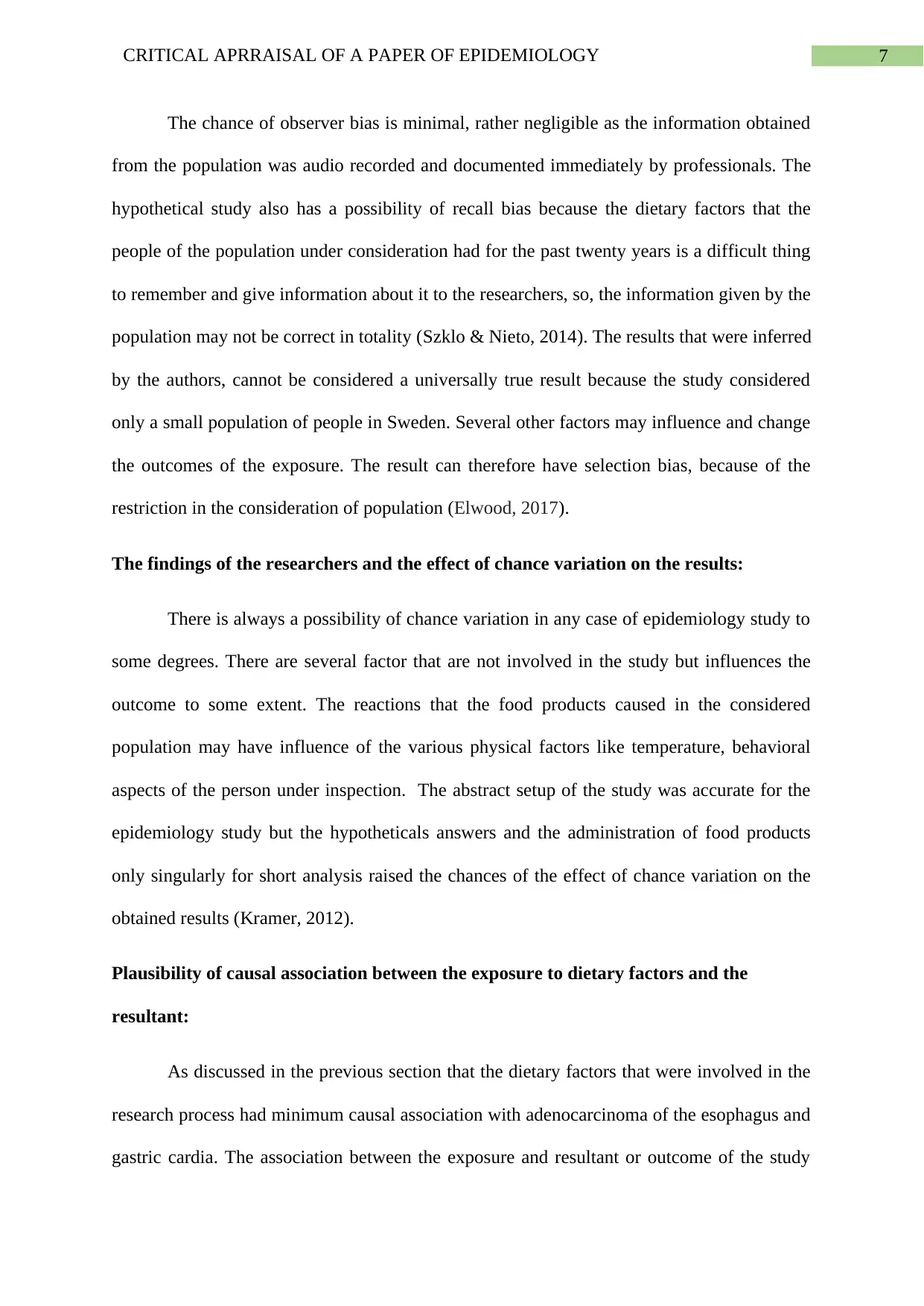
7CRITICAL APRRAISAL OF A PAPER OF EPIDEMIOLOGY
The chance of observer bias is minimal, rather negligible as the information obtained
from the population was audio recorded and documented immediately by professionals. The
hypothetical study also has a possibility of recall bias because the dietary factors that the
people of the population under consideration had for the past twenty years is a difficult thing
to remember and give information about it to the researchers, so, the information given by the
population may not be correct in totality (Szklo & Nieto, 2014). The results that were inferred
by the authors, cannot be considered a universally true result because the study considered
only a small population of people in Sweden. Several other factors may influence and change
the outcomes of the exposure. The result can therefore have selection bias, because of the
restriction in the consideration of population (Elwood, 2017).
The findings of the researchers and the effect of chance variation on the results:
There is always a possibility of chance variation in any case of epidemiology study to
some degrees. There are several factor that are not involved in the study but influences the
outcome to some extent. The reactions that the food products caused in the considered
population may have influence of the various physical factors like temperature, behavioral
aspects of the person under inspection. The abstract setup of the study was accurate for the
epidemiology study but the hypotheticals answers and the administration of food products
only singularly for short analysis raised the chances of the effect of chance variation on the
obtained results (Kramer, 2012).
Plausibility of causal association between the exposure to dietary factors and the
resultant:
As discussed in the previous section that the dietary factors that were involved in the
research process had minimum causal association with adenocarcinoma of the esophagus and
gastric cardia. The association between the exposure and resultant or outcome of the study
The chance of observer bias is minimal, rather negligible as the information obtained
from the population was audio recorded and documented immediately by professionals. The
hypothetical study also has a possibility of recall bias because the dietary factors that the
people of the population under consideration had for the past twenty years is a difficult thing
to remember and give information about it to the researchers, so, the information given by the
population may not be correct in totality (Szklo & Nieto, 2014). The results that were inferred
by the authors, cannot be considered a universally true result because the study considered
only a small population of people in Sweden. Several other factors may influence and change
the outcomes of the exposure. The result can therefore have selection bias, because of the
restriction in the consideration of population (Elwood, 2017).
The findings of the researchers and the effect of chance variation on the results:
There is always a possibility of chance variation in any case of epidemiology study to
some degrees. There are several factor that are not involved in the study but influences the
outcome to some extent. The reactions that the food products caused in the considered
population may have influence of the various physical factors like temperature, behavioral
aspects of the person under inspection. The abstract setup of the study was accurate for the
epidemiology study but the hypotheticals answers and the administration of food products
only singularly for short analysis raised the chances of the effect of chance variation on the
obtained results (Kramer, 2012).
Plausibility of causal association between the exposure to dietary factors and the
resultant:
As discussed in the previous section that the dietary factors that were involved in the
research process had minimum causal association with adenocarcinoma of the esophagus and
gastric cardia. The association between the exposure and resultant or outcome of the study
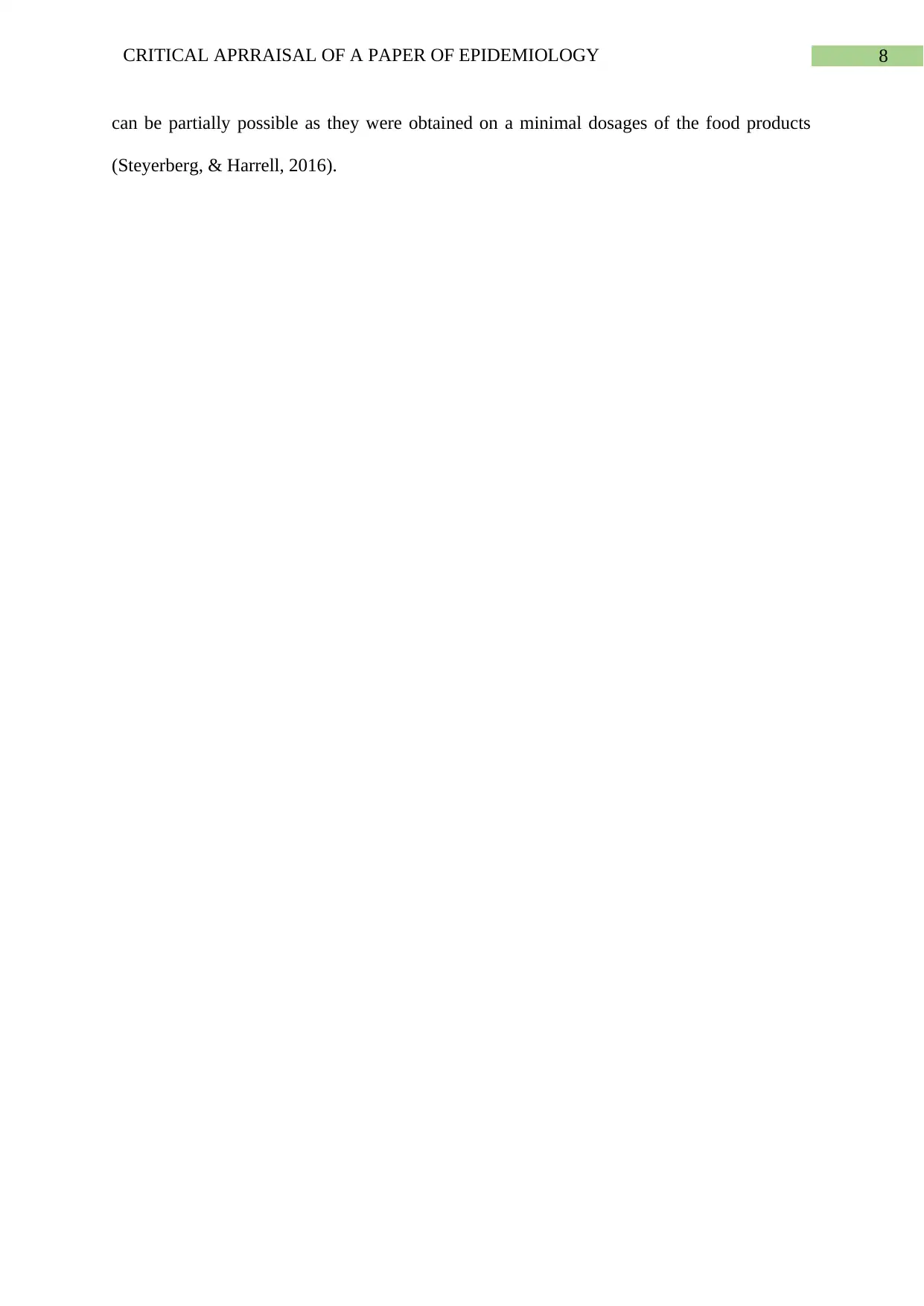
8CRITICAL APRRAISAL OF A PAPER OF EPIDEMIOLOGY
can be partially possible as they were obtained on a minimal dosages of the food products
(Steyerberg, & Harrell, 2016).
can be partially possible as they were obtained on a minimal dosages of the food products
(Steyerberg, & Harrell, 2016).
⊘ This is a preview!⊘
Do you want full access?
Subscribe today to unlock all pages.

Trusted by 1+ million students worldwide
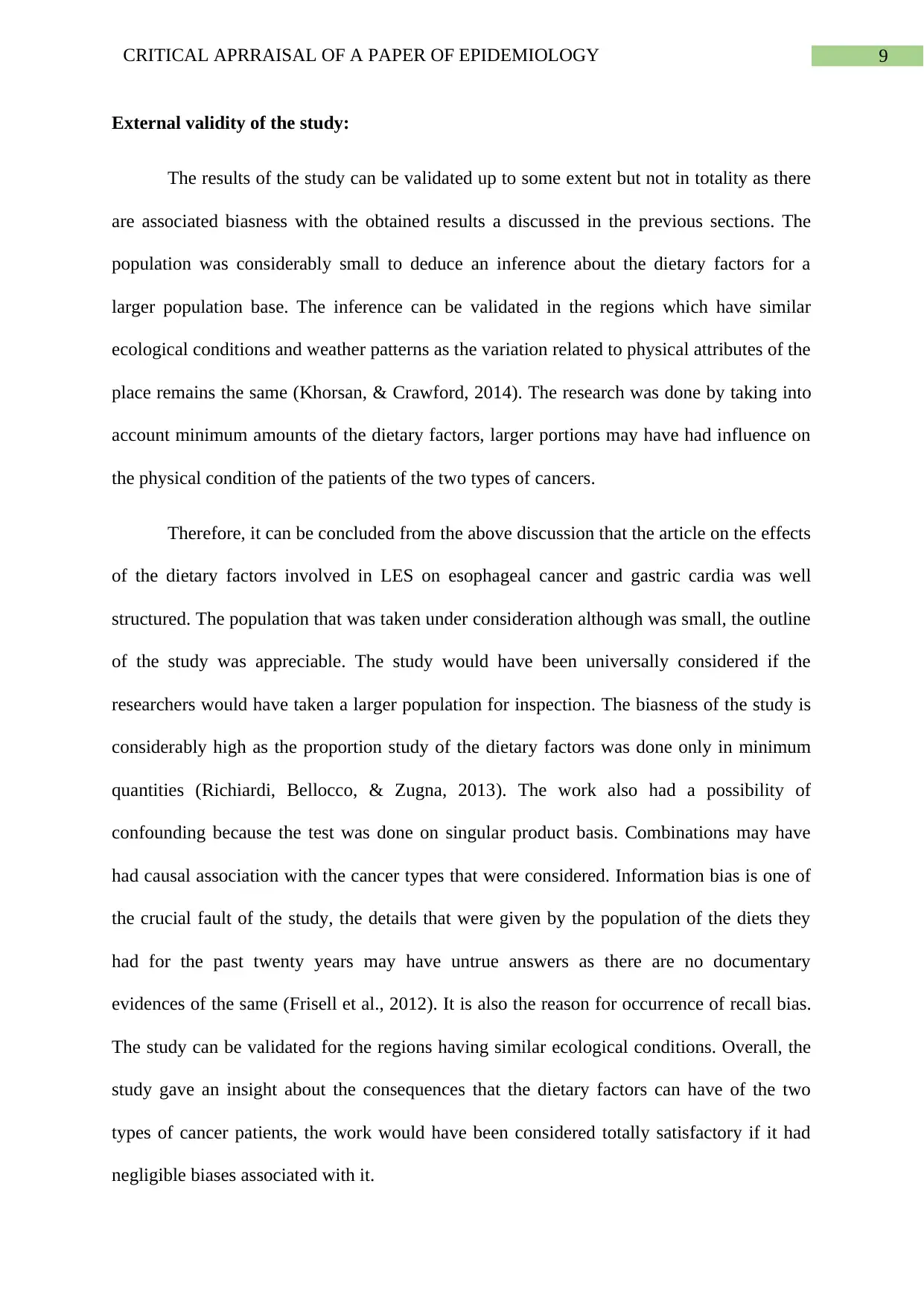
9CRITICAL APRRAISAL OF A PAPER OF EPIDEMIOLOGY
External validity of the study:
The results of the study can be validated up to some extent but not in totality as there
are associated biasness with the obtained results a discussed in the previous sections. The
population was considerably small to deduce an inference about the dietary factors for a
larger population base. The inference can be validated in the regions which have similar
ecological conditions and weather patterns as the variation related to physical attributes of the
place remains the same (Khorsan, & Crawford, 2014). The research was done by taking into
account minimum amounts of the dietary factors, larger portions may have had influence on
the physical condition of the patients of the two types of cancers.
Therefore, it can be concluded from the above discussion that the article on the effects
of the dietary factors involved in LES on esophageal cancer and gastric cardia was well
structured. The population that was taken under consideration although was small, the outline
of the study was appreciable. The study would have been universally considered if the
researchers would have taken a larger population for inspection. The biasness of the study is
considerably high as the proportion study of the dietary factors was done only in minimum
quantities (Richiardi, Bellocco, & Zugna, 2013). The work also had a possibility of
confounding because the test was done on singular product basis. Combinations may have
had causal association with the cancer types that were considered. Information bias is one of
the crucial fault of the study, the details that were given by the population of the diets they
had for the past twenty years may have untrue answers as there are no documentary
evidences of the same (Frisell et al., 2012). It is also the reason for occurrence of recall bias.
The study can be validated for the regions having similar ecological conditions. Overall, the
study gave an insight about the consequences that the dietary factors can have of the two
types of cancer patients, the work would have been considered totally satisfactory if it had
negligible biases associated with it.
External validity of the study:
The results of the study can be validated up to some extent but not in totality as there
are associated biasness with the obtained results a discussed in the previous sections. The
population was considerably small to deduce an inference about the dietary factors for a
larger population base. The inference can be validated in the regions which have similar
ecological conditions and weather patterns as the variation related to physical attributes of the
place remains the same (Khorsan, & Crawford, 2014). The research was done by taking into
account minimum amounts of the dietary factors, larger portions may have had influence on
the physical condition of the patients of the two types of cancers.
Therefore, it can be concluded from the above discussion that the article on the effects
of the dietary factors involved in LES on esophageal cancer and gastric cardia was well
structured. The population that was taken under consideration although was small, the outline
of the study was appreciable. The study would have been universally considered if the
researchers would have taken a larger population for inspection. The biasness of the study is
considerably high as the proportion study of the dietary factors was done only in minimum
quantities (Richiardi, Bellocco, & Zugna, 2013). The work also had a possibility of
confounding because the test was done on singular product basis. Combinations may have
had causal association with the cancer types that were considered. Information bias is one of
the crucial fault of the study, the details that were given by the population of the diets they
had for the past twenty years may have untrue answers as there are no documentary
evidences of the same (Frisell et al., 2012). It is also the reason for occurrence of recall bias.
The study can be validated for the regions having similar ecological conditions. Overall, the
study gave an insight about the consequences that the dietary factors can have of the two
types of cancer patients, the work would have been considered totally satisfactory if it had
negligible biases associated with it.
Paraphrase This Document
Need a fresh take? Get an instant paraphrase of this document with our AI Paraphraser
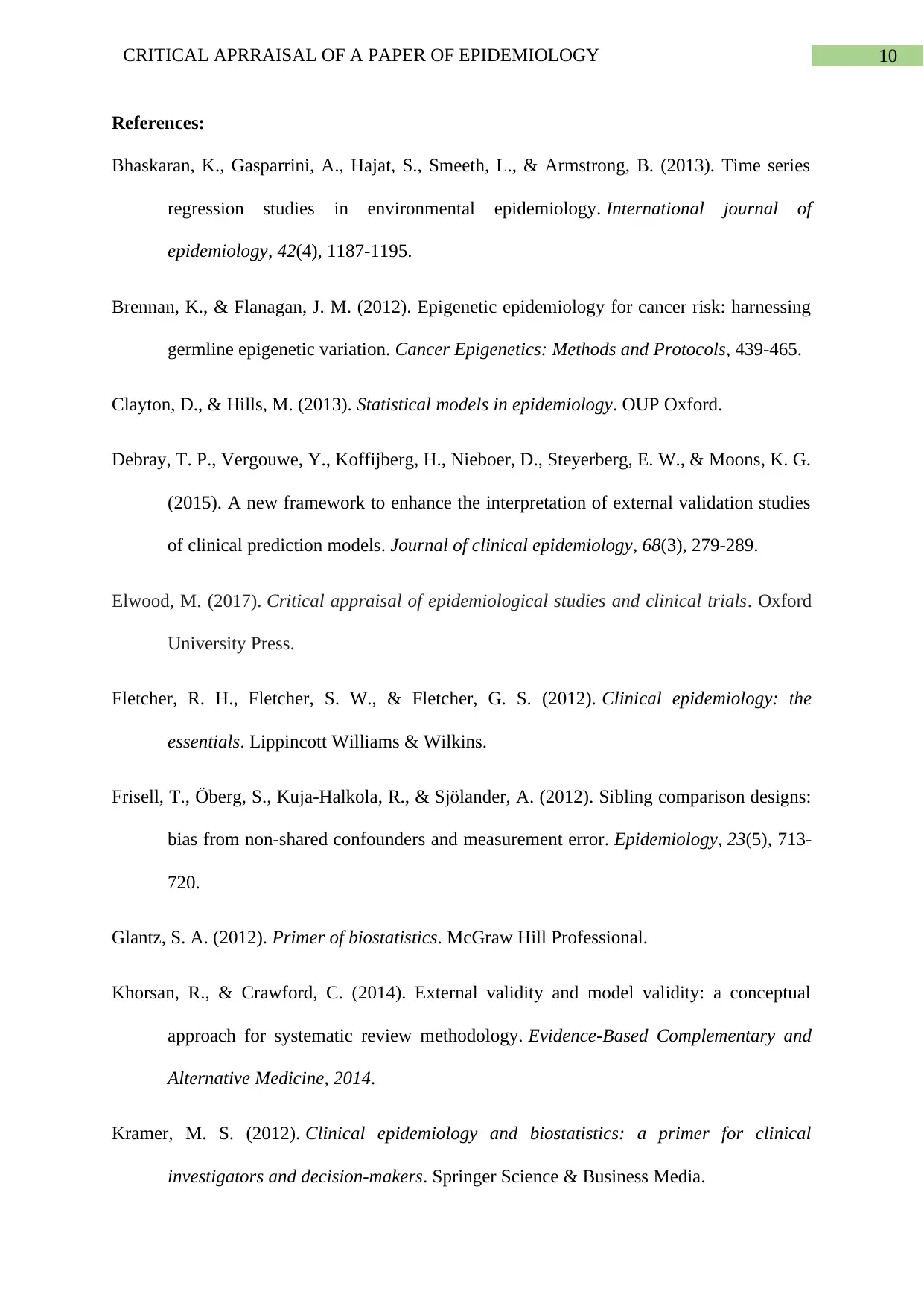
10CRITICAL APRRAISAL OF A PAPER OF EPIDEMIOLOGY
References:
Bhaskaran, K., Gasparrini, A., Hajat, S., Smeeth, L., & Armstrong, B. (2013). Time series
regression studies in environmental epidemiology. International journal of
epidemiology, 42(4), 1187-1195.
Brennan, K., & Flanagan, J. M. (2012). Epigenetic epidemiology for cancer risk: harnessing
germline epigenetic variation. Cancer Epigenetics: Methods and Protocols, 439-465.
Clayton, D., & Hills, M. (2013). Statistical models in epidemiology. OUP Oxford.
Debray, T. P., Vergouwe, Y., Koffijberg, H., Nieboer, D., Steyerberg, E. W., & Moons, K. G.
(2015). A new framework to enhance the interpretation of external validation studies
of clinical prediction models. Journal of clinical epidemiology, 68(3), 279-289.
Elwood, M. (2017). Critical appraisal of epidemiological studies and clinical trials. Oxford
University Press.
Fletcher, R. H., Fletcher, S. W., & Fletcher, G. S. (2012). Clinical epidemiology: the
essentials. Lippincott Williams & Wilkins.
Frisell, T., Öberg, S., Kuja-Halkola, R., & Sjölander, A. (2012). Sibling comparison designs:
bias from non-shared confounders and measurement error. Epidemiology, 23(5), 713-
720.
Glantz, S. A. (2012). Primer of biostatistics. McGraw Hill Professional.
Khorsan, R., & Crawford, C. (2014). External validity and model validity: a conceptual
approach for systematic review methodology. Evidence-Based Complementary and
Alternative Medicine, 2014.
Kramer, M. S. (2012). Clinical epidemiology and biostatistics: a primer for clinical
investigators and decision-makers. Springer Science & Business Media.
References:
Bhaskaran, K., Gasparrini, A., Hajat, S., Smeeth, L., & Armstrong, B. (2013). Time series
regression studies in environmental epidemiology. International journal of
epidemiology, 42(4), 1187-1195.
Brennan, K., & Flanagan, J. M. (2012). Epigenetic epidemiology for cancer risk: harnessing
germline epigenetic variation. Cancer Epigenetics: Methods and Protocols, 439-465.
Clayton, D., & Hills, M. (2013). Statistical models in epidemiology. OUP Oxford.
Debray, T. P., Vergouwe, Y., Koffijberg, H., Nieboer, D., Steyerberg, E. W., & Moons, K. G.
(2015). A new framework to enhance the interpretation of external validation studies
of clinical prediction models. Journal of clinical epidemiology, 68(3), 279-289.
Elwood, M. (2017). Critical appraisal of epidemiological studies and clinical trials. Oxford
University Press.
Fletcher, R. H., Fletcher, S. W., & Fletcher, G. S. (2012). Clinical epidemiology: the
essentials. Lippincott Williams & Wilkins.
Frisell, T., Öberg, S., Kuja-Halkola, R., & Sjölander, A. (2012). Sibling comparison designs:
bias from non-shared confounders and measurement error. Epidemiology, 23(5), 713-
720.
Glantz, S. A. (2012). Primer of biostatistics. McGraw Hill Professional.
Khorsan, R., & Crawford, C. (2014). External validity and model validity: a conceptual
approach for systematic review methodology. Evidence-Based Complementary and
Alternative Medicine, 2014.
Kramer, M. S. (2012). Clinical epidemiology and biostatistics: a primer for clinical
investigators and decision-makers. Springer Science & Business Media.
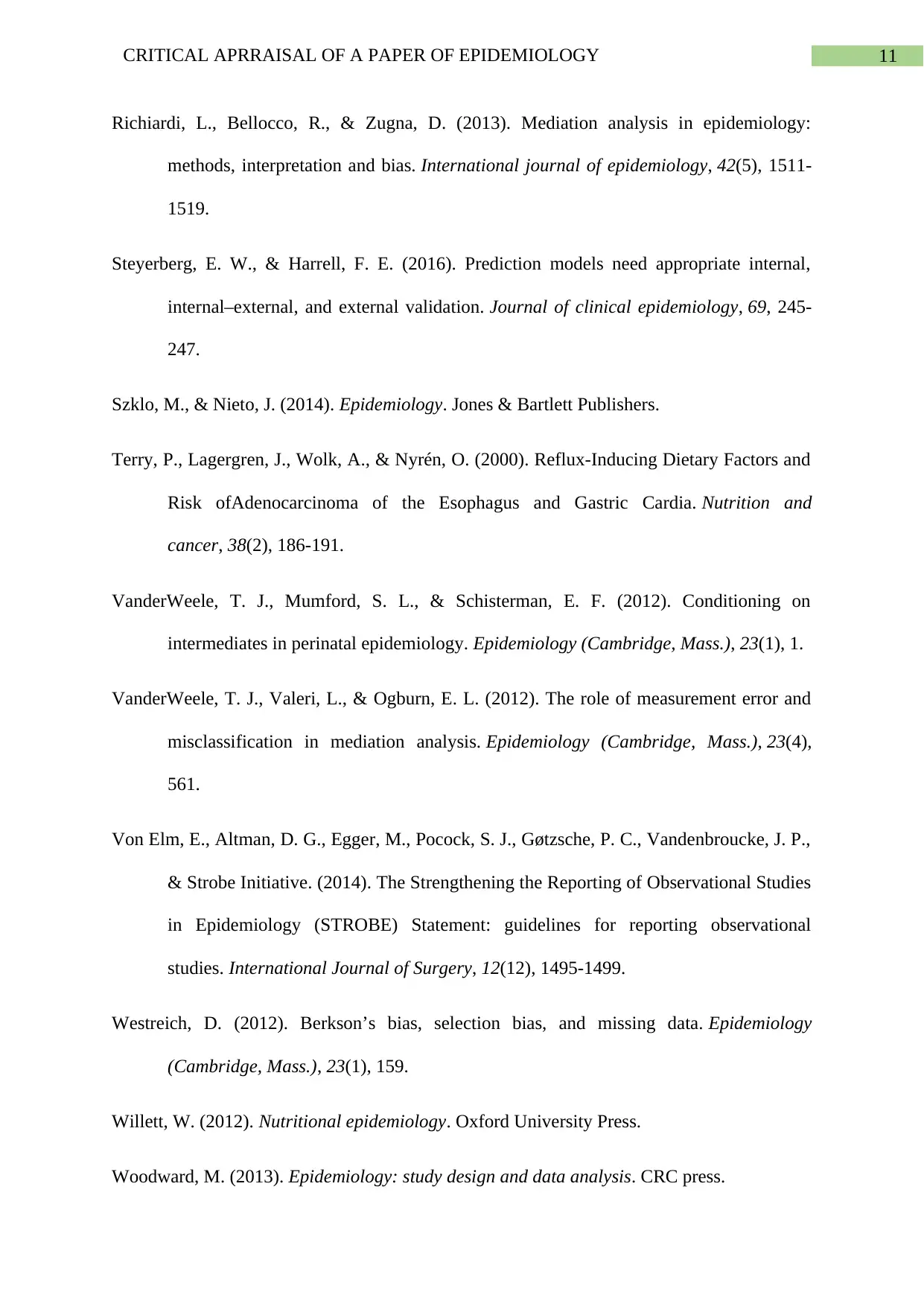
11CRITICAL APRRAISAL OF A PAPER OF EPIDEMIOLOGY
Richiardi, L., Bellocco, R., & Zugna, D. (2013). Mediation analysis in epidemiology:
methods, interpretation and bias. International journal of epidemiology, 42(5), 1511-
1519.
Steyerberg, E. W., & Harrell, F. E. (2016). Prediction models need appropriate internal,
internal–external, and external validation. Journal of clinical epidemiology, 69, 245-
247.
Szklo, M., & Nieto, J. (2014). Epidemiology. Jones & Bartlett Publishers.
Terry, P., Lagergren, J., Wolk, A., & Nyrén, O. (2000). Reflux-Inducing Dietary Factors and
Risk ofAdenocarcinoma of the Esophagus and Gastric Cardia. Nutrition and
cancer, 38(2), 186-191.
VanderWeele, T. J., Mumford, S. L., & Schisterman, E. F. (2012). Conditioning on
intermediates in perinatal epidemiology. Epidemiology (Cambridge, Mass.), 23(1), 1.
VanderWeele, T. J., Valeri, L., & Ogburn, E. L. (2012). The role of measurement error and
misclassification in mediation analysis. Epidemiology (Cambridge, Mass.), 23(4),
561.
Von Elm, E., Altman, D. G., Egger, M., Pocock, S. J., Gøtzsche, P. C., Vandenbroucke, J. P.,
& Strobe Initiative. (2014). The Strengthening the Reporting of Observational Studies
in Epidemiology (STROBE) Statement: guidelines for reporting observational
studies. International Journal of Surgery, 12(12), 1495-1499.
Westreich, D. (2012). Berkson’s bias, selection bias, and missing data. Epidemiology
(Cambridge, Mass.), 23(1), 159.
Willett, W. (2012). Nutritional epidemiology. Oxford University Press.
Woodward, M. (2013). Epidemiology: study design and data analysis. CRC press.
Richiardi, L., Bellocco, R., & Zugna, D. (2013). Mediation analysis in epidemiology:
methods, interpretation and bias. International journal of epidemiology, 42(5), 1511-
1519.
Steyerberg, E. W., & Harrell, F. E. (2016). Prediction models need appropriate internal,
internal–external, and external validation. Journal of clinical epidemiology, 69, 245-
247.
Szklo, M., & Nieto, J. (2014). Epidemiology. Jones & Bartlett Publishers.
Terry, P., Lagergren, J., Wolk, A., & Nyrén, O. (2000). Reflux-Inducing Dietary Factors and
Risk ofAdenocarcinoma of the Esophagus and Gastric Cardia. Nutrition and
cancer, 38(2), 186-191.
VanderWeele, T. J., Mumford, S. L., & Schisterman, E. F. (2012). Conditioning on
intermediates in perinatal epidemiology. Epidemiology (Cambridge, Mass.), 23(1), 1.
VanderWeele, T. J., Valeri, L., & Ogburn, E. L. (2012). The role of measurement error and
misclassification in mediation analysis. Epidemiology (Cambridge, Mass.), 23(4),
561.
Von Elm, E., Altman, D. G., Egger, M., Pocock, S. J., Gøtzsche, P. C., Vandenbroucke, J. P.,
& Strobe Initiative. (2014). The Strengthening the Reporting of Observational Studies
in Epidemiology (STROBE) Statement: guidelines for reporting observational
studies. International Journal of Surgery, 12(12), 1495-1499.
Westreich, D. (2012). Berkson’s bias, selection bias, and missing data. Epidemiology
(Cambridge, Mass.), 23(1), 159.
Willett, W. (2012). Nutritional epidemiology. Oxford University Press.
Woodward, M. (2013). Epidemiology: study design and data analysis. CRC press.
⊘ This is a preview!⊘
Do you want full access?
Subscribe today to unlock all pages.

Trusted by 1+ million students worldwide
1 out of 13
Related Documents
Your All-in-One AI-Powered Toolkit for Academic Success.
+13062052269
info@desklib.com
Available 24*7 on WhatsApp / Email
![[object Object]](/_next/static/media/star-bottom.7253800d.svg)
Unlock your academic potential
Copyright © 2020–2025 A2Z Services. All Rights Reserved. Developed and managed by ZUCOL.




